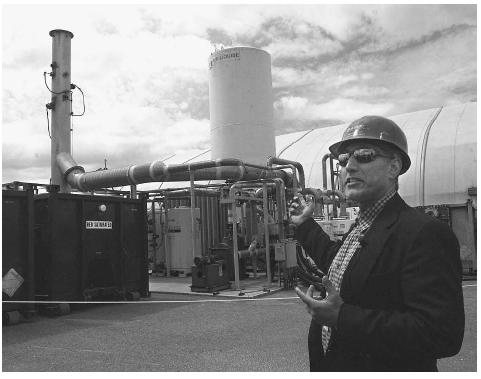Pacific Northwest National Laboratory
Since 1965, the Pacific Northwest National Laboratory (PNNL) has been managed by Battelle corporation. Beginning in the 1980s PNNL has operated as a part of the U.S. Department of Energy's national laboratory system—adding the term "National" to its name in 1995—and Battelle now manages the site for the Department of Energy's Office of Science. PNNL scientists and engineers conduct basic science research, joint research projects with private industry, and specialized research related to national security issues.
Although initially founded to conduct research work related to the Hanford nuclear site in Washington State—including the development of technology to improve safety in fabricating and handling nuclear fuels—research has since expanded to encompass an interdisciplinary approach to environmental, biotechnology, computer science, and national security related projects.
Of historical interest, PNNL scientists assisted NASA scientists in the analysis of materials collected during Apollo lunar exploration missions. PNNL studies included measurements of radionuclides that provided evidence of not only lunar processes, but of solar processes not easily measured in Earth materials. Other PNNL historical achievements include the development of optical digital recording technologies used in preparing compact discs.
In an attempt to address the growing need for finding safer modes of hazardous waste disposal, PNNL scientists developed the process of vitrification (a process that encases hazardous waste in a stable glass matrix that can then be safely stored for thousands of years). Expanding on its history in developing hazardous waste technology, more recent PNNL projects have developed new methodologies to handle nuclear tank waste often stored in deteriorating and vulnerable underground tanks. Clean up and the development of protocols for handling contaminated materials focuses on preventing radionuclide loss or other hazardous material contamination of the surrounding environment. As part of environmental research programs, PNNL scientists have developed sophisticated global climate models that allow researchers to predict the global atmospheric spread of hazardous materials or the movement of hazardous wastes through groundwater systems. PNNL-developed technology assists monitoring of nuclear testing ensures adherence to the Comprehensive (Nuclear) Test Ban Treaty (CTBT).

PNNL's Chemical and Biological Defense Program is continuing research into detection technologies capable of identifying prohibited chemical and biological agents. PNNL technologies that facilitate pathogen detection include the Matrix-Assisted Laser Desorption/Ionization Mass Spectrometry (MALDI-MS) program that utilizes mass spectrometry to rapidly identify pathogens. Instead of conventional bio-identification procedures that can take days of laboratory analysis time—and thus, delay effective response to acts of bioterrorism—MALDI-MS holds the potential to allow pathogen identification within minutes. For example, the Biodetection Enabling Analyte Delivery System (BEADS) analyzes microbe DNA for pathogen identification. In conjunction with private industry, PNNL projects include the development and evaluation of systems to effectively distribute enzymes and chemicals that decontaminate a structure following chemical or biological agent exposure.
In partnership with U.S. Department of Energy's Hazardous Materials Management and Emergency Response (HAMMER), PNNL staff offers training to law enforcement officers, emergency medical responders, and military personnel in methods of managing responses to potential nuclear, chemical, or biological accidents and deliberate acts of terrorism.
To support inspection efforts—such as those conducted by U.N. weapons inspectors in Iraq prior to the 2003 U.S.-led war against Iraq—PNNL scientists developed acoustic inspection devices that were capable of detecting compartments inside liquid-filled containers.
Other PNNL projects related to national security include a holographic imaging system that enhances noninvasive personal screening for use by the Federal Aviation Administration.
█ FURTHER READING:
ELECTRONIC:
Pacific Northwest National Laboratory. March 2003. < http://www.pnl.gov/ > (April 2, 2003).
United States Department of Energy, Office of Science. National Laboratories and User Facilities. < http://www.sc.doe.gov/Sub/Organization/Map/national_labs_and_userfacilit es.htm > (March 23, 2003).
United States Department of Homeland Security. Research & Technology. < http://www.dhs.gov/dhspublic/display?theme=27&content=374 > (March 23, 2003).
SEE ALSO
Argonne National Laboratory
Brookhaven National Laboratory
DOE (United States Department of Energy)
Environmental Measurements Laboratory
Lawrence Berkeley National Laboratory
Lawrence Livermore National Laboratory (LLNL)
Los Alamos National Laboratory
NNSA (United States National Nuclear Security Administration)
Oak Ridge National Laboratory (ORNL)
Plum Island Animal Disease Center
Sandia National Laboratories
Comment about this article, ask questions, or add new information about this topic: